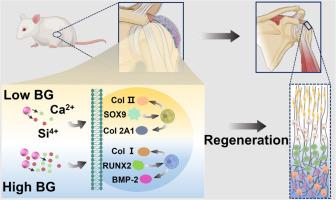带生物活性玻璃的梯度水凝胶用于肌腱-骨界面再生:增强生物力学强度和同步组织再生。
IF 9.6
1区 医学
Q1 ENGINEERING, BIOMEDICAL
引用次数: 0
摘要
肌腱与骨之间的界面具有小尺寸、局部区域的梯度多组织结构,肌腱止点断裂修复后不能完全再生。因此,肌腱-骨愈合仍然是运动医学领域的一个重大挑战。本研究旨在以生物活性玻璃(BG)、改性海藻酸盐(AlgMA)和明胶为原料,设计并制备具有连续离子浓度梯度的生物活性水凝胶。在持续释放生物活性离子和梯度诱导信号的条件下,骨髓间充质干细胞(BMSCs)可以成功分化为软骨细胞和成骨细胞,有助于促进肌腱-骨界面再生。体内实验结果表明,与其他组相比,BG梯度水凝胶的梯度矿化纤维软骨形成更优,纤维软骨比例最高(35.65%),分别是均匀水凝胶组和对照组的1.36倍和4.4倍。梯度水凝胶的植入促进了肌腱-骨界面肌腱、纤维软骨和骨的同步再生,从而增强了端骨的生物力学强度。这些发现表明,使用这种仿生bg梯度水凝胶支架可能是支持肌腱止点撕脱伤修复的有力工具。重要意义:肌腱-骨界面的梯度结构是众所周知的损伤后愈合的挑战。为了应对这一挑战,本研究提出了一种创新的解决方案,包括将BG与光交联海藻酸盐/明胶水凝胶结合。这种组合旨在构建一种连续的离子浓度梯度水凝胶,有效地模拟存在于肌腱-骨界面的天然羟基磷灰石梯度。体内实验证明,通过引导骨髓间充质干细胞向高BG区成骨细胞和低BG区软骨细胞分化,实现了同时多组织再生。这项研究不仅提出了一种可扩展和可重复的制造策略,而且还引入了一种功能性硬-软组织界面的新范例,在韧带-骨和软骨-骨修复中具有潜在的应用前景。本文章由计算机程序翻译,如有差异,请以英文原文为准。

Gradient hydrogel with bioactive glass for tendon-bone interface regeneration: Enhancing biomechanical strength and synchronized tissue regeneration
The interface between tendon and bone is characterized by a gradient multi-tissue structure in a small-sized, localized region, and the tendon insertion cannot fully regenerate following repair for its rupture. Therefore, tendon-bone healing remains a significant challenge in the field of sports medicine. This study aims to design and fabricate a bioactive hydrogel with a continuous ion concentration gradient, using bioactive glass (BG), modified alginate (AlgMA), and gelatin. Under the condition of the sustained release of bioactive ions and gradient-induced signals, bone marrow mesenchymal stem cells (BMSCs) can be successfully differentiated into chondrocytes and osteoblasts, which aids in promoting tendon-bone interface regeneration. In vivo experimental results demonstrated that the hydrogel with a BG gradient exhibited superior formation of gradient mineralized fibrocartilage compared to other groups, with the highest fibrocartilage proportion (35.65 %), which was 1.36-fold and 4.4-fold higher than that of the uniform hydrogel group and the control group, respectively. The implantation of the gradient hydrogel facilitated the synchronized regeneration of tendon, fibrocartilage, and bone at the tendon-bone interface, thereby enhancing the biomechanical strength of the enthesis. These findings suggest that using this biomimetic BG-gradient hydrogel scaffold could be a powerful tool supporting the repair of tendon insertion avulsion.
Statement of significance
The gradient structure at the tendon-bone interface is notoriously challenging to heal following injury. To address this challenge, this study proposes an innovative solution that involves the combination of BG with photocrosslinked alginate/gelatin hydrogels. This combination aims to construct a continuous ionic concentration gradient hydrogel that effectively mimics the natural hydroxyapatite gradient present at the tendon-bone interface. Simultaneous multi-tissue regeneration was achieved by directing the differentiation of BMSCs into osteoblasts in high BG regions and chondrocytes in low BG regions, as demonstrated by in vivo experiments. This study not only presents a scalable and reproducible fabrication strategy but also introduces a new paradigm for functional hard-soft tissue interfaces, with potential applications in ligament-bone and cartilage-bone repair.
求助全文
通过发布文献求助,成功后即可免费获取论文全文。
去求助
来源期刊

Acta Biomaterialia
工程技术-材料科学:生物材料
CiteScore
16.80
自引率
3.10%
发文量
776
审稿时长
30 days
期刊介绍:
Acta Biomaterialia is a monthly peer-reviewed scientific journal published by Elsevier. The journal was established in January 2005. The editor-in-chief is W.R. Wagner (University of Pittsburgh). The journal covers research in biomaterials science, including the interrelationship of biomaterial structure and function from macroscale to nanoscale. Topical coverage includes biomedical and biocompatible materials.
 求助内容:
求助内容: 应助结果提醒方式:
应助结果提醒方式:


